Veteran’s Testimony – Arthur R. Mann 37th Medical Hospital Ship Platoon (Separate)

Photo of Technician 5th Grade Arthur R. Mann, ASN 36242816, 37th Medical Hospital Ship Platoon (Separate).
Introduction:
Arthur Royal Mann was born May 12, 1920 in Milwaukee, Wisconsin. Art graduated from Rufus King High School, Milwaukee in 1938. After going through one year of College, Arthur worked as a skilled meat cutter in his Dad’s meat market, except in slaughtering and packing. His only sibling was Dorothy M. Mann. Arthur Mann’s Parents were Royal Mann and Wilhelmina Hoth.
On February 28, 1942, Arthur Mann married Elizabeth Christina Ochs. Elizabeth was born November 21, 1921, graduated from North Division High School, Milwaukee, Wisconsin, and worked in an engraving department. Quite a number of her siblings (she had 11) served Uncle Sam well. They were John H. Ochs (Corps of Engineers); Carl Ochs (Army Air Corps); Philip H. Ochs (Antiaircraft Artillery); Elias Ochs (Army Air Corps); and Richard D. Ochs (Marine Corps/Air Force).
Elizabeth and Arthur Mann would be blessed with 4 children: Phillip Bruce Mann (born 1943); Ronald Phillip Mann (born 1946); Russell Alan Mann (born 1947); and Patricia Ellen Mann (born 1952).
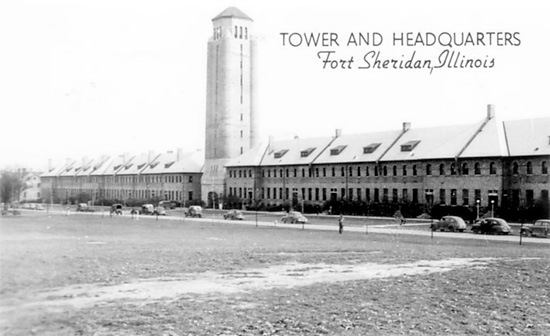
Vintage photo illustrating part of Fort Sheridan, Highwood, Illinois, buildings.
After being inducted on May 29, 1942, at Fort Sheridan, Illinois, Arthur took his basic training with the US Army Medical Department at Camp Grant, also in Illinois. He once told his wife in a letter, “the Medical Corps is a heck of a place to put a butcher !” Private A. R. Mann, was eventually assigned to a Medical Hospital Ship Platoon and from that time on, life in the service became more of a sailor’s job than a soldier’s. As a matter of fact, half of his time would be spent overseas, including many stays in North Africa, Italy, and Europe.
Military Service:
On December 15, 1941, Local Board No. 9, Milwaukee County, Wisconsin, addressed an invitation to Arthur Mann, Selectee #S-2947, to report for a physical examination, on Friday, December 19, 1941.

Copy of Invitation issued by the Local Board No. 9, Milwaukee County, Wisconsin, dated December 15, 1941 addressed to Selectee Arthur R. Mann (Selectee #S-2947) to report for Physical Examination on December 19, 1941.
Arthur R. Mann joined the service the same day of his induction, May 29, 1942, at the Fort Sheridan Reception Center (Ft. Sheridan, Highwood, Illinois, was a Military Post, with a total acreage of 729 and a troop capacity for 692 Officers and 12,313 Enlisted Men –ed). After being inducted, Private Arthur R. Mann, ASN 36242816, took Basic Training at Camp Grant, Rockford, Illinois (Medical Replacement Training Center, total acreage 3,349; troop capacity 453 Officers and 20,836 Enlisted Men –ed) after which he took a course for Cooks, while serving in Company D / 36th Medical Training Battalion. Private Mann successfully completed the instruction course, graduating on August 1, 1942.
Following more training at Camp Grant, Illinois, Private Arthur R. Mann, was now assigned to the 37th Medical Hospital Ship Platoon, designated to serve aboard USAHS “Seminole”. In November of 1942, Private Arthur Mann was sent to Camp Kilmer, New Jersey, where the unit he was assigned to was in the process of being officially activated.
First Assignment:
The 37th Medical Hospital Ship Platoon (Separate) was activated at Camp Kilmer, Stelton, New Jersey (Staging Area for New York Port of Embarkation; total acreage 1,815; troop capacity 2,047 Officers and 35,386 Enlisted Men –ed) on November 20, 1942, per Paragraph # 1, General Orders # 28, Headquarters Camp Kilmer, dated November 20, 1942, with the following named personnel:
| Officers: | |
| Captain George L. Walker, MC – Commanding Officer & Senior Medical Officer | |
| 1st Lieutenant Paul C. Soulsby, MC – Junior Medical Officer | |
| 1st Lieutenant Charles G. Durand, DC – Dental Officer | |
| Enlisted Men: | |
| Sergeant Lorne W. Thompson | Private Phillip J. Campbell |
| Technician 5th Grade Herman L. Perkel | Private William C. Foreman |
| Technician 5th Grade Leslie L. Reynolds | Private Alfred Herndon |
| Private First Class Ernest E. Jerina | Private Howard Holloway |
| Private First Class Clyde M. Markeson | Private Henry L. Karwaski |
| Private First Class Edward E. Muters | Private Lewis B. Lee |
| Private First Class Edward F. O’Day | Private Arthur R. Mann |
| Private First Class Birdette Smith | Private George S. Manolakas |
| Private First Class Stanford C. Van de Mark | Private John W. Rodgers |
| Private Perry R. Bishop | Private William P. Roe |
| Private Harold F. Brown | Private Harold W. Rossiter |
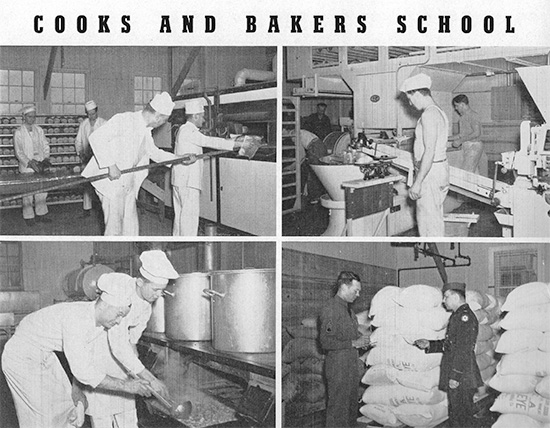
Photo illustrating activities at the Cooks and Bakers School, Camp Grant, Rockford, Illinois, dated 1942.
The majority of the assigned EM came from Camp Grant, Rockford, Illinois (Medical Replacement Unit Training Center –ed) although some of them arrived from other Stations in the ZI.
On 24 November 1942, per Orders issued by New York Port of Embarkation, Brooklyn, N.Y., the following ANC Officers were assigned:
| 2d Lieutenant Ruth H. Murphy – Chief Nurse |
| 2d Lieutenant Helen K. Alexander |
| 2d Lieutenant Helen M. Donadee |
| 2d Lieutenant Elizabeth P. Kapusinski |
| 2d Lieutenant Mary C. Tkacik |
On the same day, a program of active training was started.
For some unknown reason, orders activating the Platoon were held up for two weeks and during that period the members of the 37th Medical Hospital Ship Platoon were considered AWOL by the authorities in Washington! When orders finally came in, the work of forming and starting the new organization was hurriedly begun. It took more than a full week to get the unit working as a whole.

Copy of Certificate issued by the Medical Department Special Schools, United States Army, dated 1 August 1942, awarded to Private Arthur R. Mann, ASN 36242816, D Company, 36th Medical Training Battalion, after successfully completing a Course of Instruction for Cooks, at the Cooks and Bakers School, Camp Grant Medical Replacement Training Center, Rockford, Illinois.
Preparation for Overseas Movement:
Training continued until December 8, 1942 when alert orders were received to prepare to embark the following day for an overseas destination.
On December 9 the Platoon left Camp Kilmer, Stelton, New Jersey, by truck at 1500 hours. The group arrived at the Staten Island Terminal at 1800 hours the same day and immediately boarded USAT “George W. Goethals”, AP-182 (launched January 23, 1942 and delivered to the US Army September 18, 1942 –ed).
The ship set sail at 1045 hours, December 10, 1942 part of a large convoy.
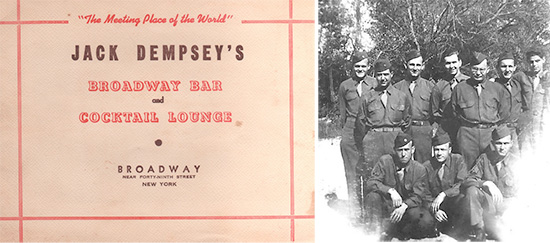
Copy of vintage card cover advertising Jack Dempsey’s Broadway Bar & Cocktail Lounge (near Forty-Ninth Street, New York, called “The Meeting Place of the World”, frequented by numerous US Armed Forces personnel). Miscellaneous group of 37th Medical Hospital Ship Platoon personnel.
At first sailing was smooth and everyone seemed to enjoy the journey, when suddenly, after traveling some 180 miles, all the ship’s engines stopped. It was night and the rest of the convoy knowing nothing of the “George W. Goethals” plight, continued its journey, leaving the vessel on her own in the Atlantic. A storm came up and with the weather turning really rough, fog, the disabled vessel, with no lights, no heat, and scarce drinking water, really looked like she was going to experience an eventful journey. Rolling furniture and baggage, and most of the Platoon seasick by the time, made life very unpleasant for the passengers and crew. After drifting at the mercy of the storm for 22 long hours, the sound of engines humming again was most welcome to everyone on board!
Having lost the convoy and with no protection, the ship’s Captain decided to return to New York which was reached at 2330 hours, December 14, 1942.
Crew and Medical Platoon remained on board while repairs were being made. Fortunately all the Officers, the Nurses, including the Enlisted Men received 7-day passes, except for 2 EM, who being too far from home, were therefore unable to make the return trip home in such a short time. All the men returned on time except 2, who were considered AWOL as from 0600 hours, December 28. One of them returned January 2, and the other on January 4, 1943, they rejoined the unit after it was decided to keep everyone on board. The Platoon remained on board ship until January 6, 1943, until Captain George L. Walker received orders assigning and attaching the 37th Medical Hospital Ship Platoon to the Station Hospital, Camp Kilmer, Stelton, New Jersey. The orders emanated from Headquarters Staten Island Terminal and were dated December 29, 1942.
The unit left the Brooklyn repair dock returning to camp Kilmer where it arrived at 1900 hours, January 6, 1943, after spending a cold and uncomfortable trip. Upon arrival, training was started again. As from January 21, 1943, all Nurses attached to the Platoon were now placed on SD at the Station Hospital, Camp Kilmer. Training was to continue throughout the month of January. A few men were given emergency furlough for family reasons; others were in hospital because of sickness or accidents. Some of the men did not return in time and were considered to be AWOL until returned. Duties continued with regular assignments to the local dispensary. Around the end of January, 3 Enlisted Men received promotions as Noncommissioned Officers. On February 15, 1943, 2 EM were still in hospital (cyst + broken leg) and were therefore transferred to a Task Force Replacement Pool. They were replaced by two new men. Training schedules and regular duties continued in February and March of 1943. On March 15, another 6 EM received promotions. By April 1943, the entire 37th was on duty at the Station Hospital.
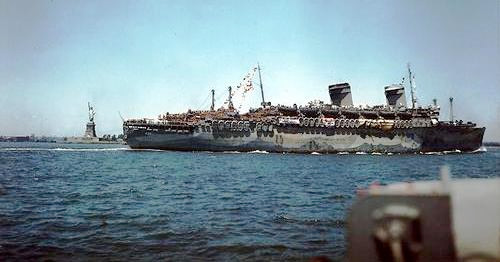
Vintage photo illustrating troopship USS West Point, AP-23. This particular photo illustrates the ship arriving at New York Port of Embarkation in July 1945 with US troops returning from the European Theater.
On May 7, 1943, new orders were received instructing the Platoon to prepare for shipment overseas. All men were released from duties to pack and prepare for a last processing. The Platoon remained on “alert” status from May 7 until May 12, when orders came to move to the Staten Island Terminal at 2200 hours. One of the NCOs was transferred out of the Platoon and replaced by Technician 5th Grade William Carroll, previously with the 609th Medical Hospital Ship Platoon. The organization departed Camp Kilmer at 2300 hours by truck and arrived at Staten Island Terminal at 0130 hours, the next morning.
The 37th Medical Hospital Ship Platoon boarded the USS “West Point” AP-23 (built in 1940, acquired by the US Navy May 28, 1941 and converted to a troopship June 15, 1941 –ed) at 0200 hours sharp, May 13, 1943, and began its journey across the Atlantic (for the second time) for a destination unknown … the vessel was traveling alone carrying 8,409 passengers.
North Africa 1:
The crossing was uneventful, with the traditional exercises and security drills on board. Some of the EM pulled a few medical and other details while crossing. Only 2 meals were served each day and food quality was rather poor. As the ship was overcrowded, men could only go on deck at designated hours.
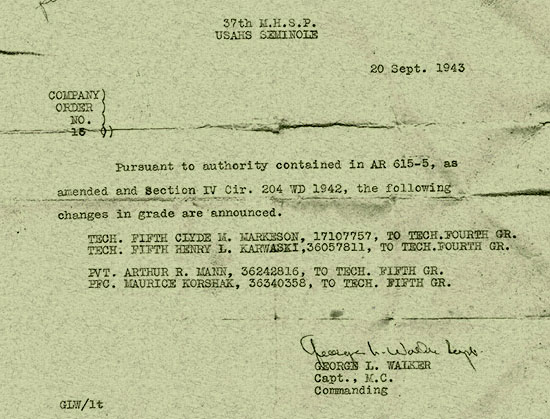
Copy of General Order No. 15, dated 20 September 1943, issued by the 37th Medical Hospital Ship Platoon, announcing promotion to a higher grade for 4 Enlisted Men, including Technician 5th Grade Arthur R. Mann, ASN 36242816.
The USS “West Point” arrived in Casablanca, French Morocco, on May 20, 1943 after having traveled 4,600 miles. At 1500 hours, all ANC Officers debarked and entrucked for the Lycée Lyautey where they were to be quartered. At 1600 hours the remainder of the Platoon debarked and marched 7 miles to Camp Don B. Passage, where they were to be stationed, awaiting further instructions. No duties had to be performed while stationed in the camp, except guard duty one night only.
Operations
June 2, 1943 the organization received orders to move to Prisoner of War Enclosure # 100 some twenty miles south of Casablanca. The Platoon entrucked for their new assignment on June 3 and following arrival and briefing, were placed on duty in the hospital compound run by the 56th Station Hospital (the largest hospital for PWs captured in the Tunisian Campaign with an average population of 20,000 and a maximum of 28,000. Patient census varied from 205 to 978, averaging about 750. The installation consisted of 9 prefab buildings supplemented by tentage. In addition, the 56th Sta Hosp maintained small dispensaries in various parts of the compound where outpatient service was given to 300 – 400 patients a day –ed). The Nurses were equally assigned to duty at the same hospital. However, they only worked there in daytime, and were taken back to their quarters by truck each night. The Enlisted personnel slept on the ground a few days until wooden floors were put in the tents by some PWs. At the time of arrival the PWE held approximately 30,000 German and Italian prisoners. While the men were placed on duty in the wards others were assigned duty in the hospital mess hall. The Nurses joined the men and moved out to PWE # 100 after quarters had been built for them. Although the food was good the size of the mess hall was limited so many had to eat outside which proved impossible most of the time due to hard winds and insects. Since the 56th Sta Hosp staff was inadequate to operate with limited numbers, they were supplemented by detachments of 3 Officers – 6 Nurses – and 22 Enlisted Men each from the 34th, 36th and 37th Medical Hospital Ship Platoons; by 2 German Medical Officers and by another 100/120 German medical aidmen and technicians working under their own NCOs.

Copy of individual Pass to Private Arthur R. Mann, ASN 36242816 dated 1943, granting access to Prisoner of War Enclosure # 100, issued by the Atlantic Base Section (ABS) activated in Casablanca, French Morocco, in 1943. The stamp PWC-100 designates Prisoner of War Cage No. 100).
At the end of the Tunisian Campaign 275,000 axis prisoners were taken. This created an unexpected problem for which Allied authorities were inadequately prepared. After an agreement was reached with (British) Maj. General Ernest M. Cowell and Maj. General Frederick A. Blesse, and with the support of the US Provost Marshal captured medical and sanitary personnel were divided between US and British organizations according to need. Initially enemy PWs captured in Tunisia were treated in regular US Army hospitals with normal staffs supplemented by prisoner personnel. German and Italian PWs of the Tunisian Campaign were cared for both in Algeria and French Morocco.
56th Station Hospital
4 May 1943 > 14 May 1943 – Berrechid, French Morocco (PWE # 100 was closed August 15)
14 May 1943 > 28 February 1945 – Casablanca, French Morocco
Some Enlisted personnel received promotions on June 10, 1943. Two (2) EM were busted to Privates for having been arrested without a pass and also for being drunk. After a while some personnel of the command were admitted to the hospital, suffering from malaria, fever, and stomach disorder. Ward # 4 was placed in quarantine for about two weeks. Because of the situation, the Platoon personnel were moved to different tents approximately 100 yards from the main camp body along with the 36th Medical Hospital Ship Platoon. Quarantine was off July 17, 1943 and several of the enemy patients were discharged and returned to the PW compound. During this period no problems were encountered with the GC-protected German and Italian medical ward personnel who proved very good and docile workers.
On July 22, 1943, 3 Privates went AWOL. As they had been drinking they returned to the station late at night and in a very bad shape. All were disciplined and one court-martialed.
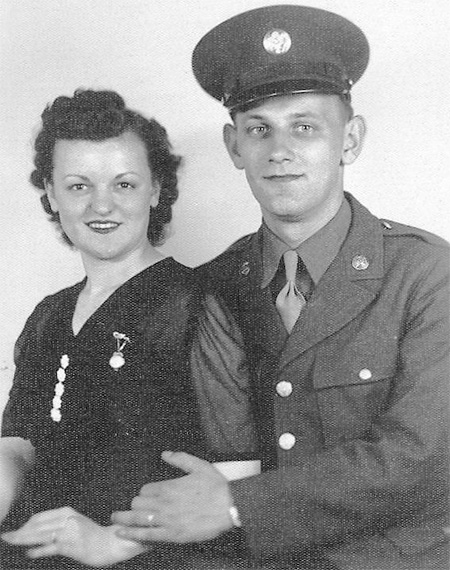
Photo illustrating Private Arthur R. Mann and his wife Elizabeth C. Ochs. Photo taken some time in 1943, before leaving for overseas.
Two more units, the 549th and the 550th Medical Hospital Ship Platoons arrived and were placed on DS with the 37th. Both consisted of 22-man Platoons. August 1, 1943, found the unit still working at PWE # 100. The weather was still hot and dry, with no rain for the last two months. The nights were cool and showers were available in ward # 4.
On the night of August 6, orders were received to pack and move out the next morning at 0600 hours. The 37th moved by motor convoy to Casablanca and the harbor and boarded the “Empress of Scotland” (during 1943-1944 she operated a shuttle service between New York and Europe, effecting 12 round-trip journeys bringing US troops to the United Kingdom in preparation for the Invasion of the Continent –ed) at 0930 in the morning. About 1,000 enemy PWs were aboard the ship. After more patients were carried aboard, the transport slowly moved away from the docks at 1815 hours, starting its journey across the Mediterranean and the Atlantic. Everybody was quite happy, as the destination was the United States!
Zone of Interior
The “Empress of Scotland” reached New York POE August 16, 1943. During the trip all of the Enlisted personnel (except 3 men too sick to work) performed ward duty. After debarking, the unit was moved by truck to Camp Kilmer where they arrived at 1700 hours. On August 18, everyone was given a 15-day pass. On August 24, 1943, all the men were recalled by telegram. While the men kept coming in until August 27 (again some went AWOL and did only return later) orders were received for a transfer to Charleston, South Carolina. At this time only 13 out of the original 22 EM were present. Meanwhile an order had been passed to reduce personnel strength to only 3 Officers, 3 Nurses, and 21 Enlisted Men. Replacements were called for and came from the Replacement Pool at Camp Kilmer. The re-organized 37th then moved to Charleston, S.C. where they arrived at 1700 hours, August 28, 1943.

Copy of official Letter dated 17 March 1944, issued by Headquarters, 37th Medical Hospital Ship Platoon (while stationed at Camp Patrick Henry Staging Area, Oriana, Virginia), announcing authorization for a number of Enlisted Men to wear the American and European-African-Middle Eastern Campaign ribbons as well as the Army Good Conduct ribbon, including Technician 5th Grade Arthur R. Mann, ASN 36242816.
The unit consisted of:
Captain George L. Walker – Commanding Officer
1st Lieutenant Sidney Melnick
1st Lieutenant Ruth H. Murphy – Chief Nurse
2d Lieutenant Elizabeth P. Kapusinski
2d Lieutenant Mary C. Tkacik
First Sergeant Lawrence W. Thompson, 16017628
Sergeant Harold W. Rossiter, 17018425
Technician 4th Grade Henry L. Karwaski, 36057811
Technician 4th Grade Lewis B. Lee, 34334435
Technician 4th Grade Clyde M. Markeson, 171017757
Technician 5th Grade Irving Baggish, 31312121
Technician 5th Grade William Carroll, 12151729
Technician 5th Grade Maurice Korshak, 36340358
Technician 5th Grade Arthur R. Mann, 36242816
Technician 5th Grade William P. Roe, 32503740
Private First Class Harold F. Brown, 32527093
Private First Class Darrel B. Hammond, 36344939
Private First Class Edward F. O’Day, 36360562
Private First Class William J. Reynolds, 33584725
Private Mario Aguilar
Private William C. Foreman
Private Robert N. Gordon, 33502147
Private Alfred Herndon
Private Wilbert R. Wernath
Private Jim Williamson
Private Littleton A. Woods, 38436120

Photos taken of 37th Medical Hospital Ship Platoon men while stationed at Llandudno, Wales, United Kingdom, in May 1944.
The organization spent about 11 days in Charleston and during its stay no one was assigned to duty of any kind. Everyone received a new series of shots, and drew the necessary clothing and equipment that was required. On September 6, 1943, orders were received to pack the equipment and individual bags and be ready to move once more. On of the EM went AWOL for three days and was therefore replaced by Private Norbert M. Lisk.
The 37th entrained at 1015 hours, September 7, for Fort Hamilton, New York, where it arrived at approximately 1500 hours the next day. While at the station, most of the men pulled various details, and otherwise conducted drill and marches. September 19, alert orders were received to be ready to board ship for a destination unknown. On September 20, 1943, the organization went up the gangplank to board USAHS “Seminole” (Hospital Ship) which set sail for North Africa at 1320 hours the same day.
Pursuant to authority contained in Army Regulations 615-5, as amended and Section IV, Circular 204, War Department 1942, and Company Orders No. 16, dated September 20, 1943, Private Mann was promoted to Technician 5th Grade.
North Africa 2:
The 37th Medical Hospital Ship Platoon arrived in Oran, Algeria, October 1, 1943. Following debarkation the organization moved to Camp # 2 where they performed regular camp duties. On October 24, orders were received to move to the site of the 21st General Hospital, located at Sidi-Bou-Hanifia (Oran area), Algeria. After assembly the group entrucked for the new location at 1330 hours, and arrived on site at approximately 1615 hours, October 25. During this time, the three Nurses were stationed at the 2d Convalescent Hospital some ten miles from Oran. The unit was to stay with the 21st Gen Hosp until November 21, 1943. One very welcome convenience was that there was hot water to be had at any time, day or night (the hospital site was near a hot water spring –ed).
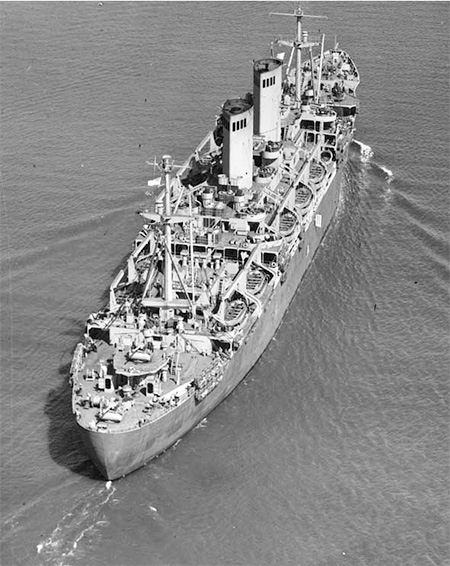
Vintage photo illustrating Troopship USS General Montgomery C. Meigs, AP-116. This particular photo illustrates the ship which carried the staff and personnel of the 37th Medical Hospital Ship Platoon to Hampton Roads Port of Embarkation, Zone of Interior, in August 1944.
21st General Hospital
29 December 1942 > 30 November 1943 – Sidi-Bou-Hanifia, Algeria
2d Convalescent Hospital
28 February 1943 > 31 May 1944 – Bouisseville, Algeria
180th Station General
1 October 1943 > 15 April 1944 – Bouisseville, Algeria
November 21, 1943, VOCO orders were received from the Port Surgeon, Oran, Algeria, to move immediately to the 180th Station Hospital for DS. Being given only 15 minutes, the staff and personnel immediately set to pack and were ready to move by 1500 hrs. The 37th reached their destination at 1775 hours. After a short briefing, most men were assigned to ward duty while the remainder were to do utilities work around the camp area.
On November 25, 1943, 1st Lieutenant Sidney Melnick was promoted to Captain (as per extract, Special Orders No. 265, dated September 22, 1943). After demonstrating his proficiency in driving, Tec 5 A. Mann obtained the necessary authorization as per NATOUSA Headquarters dated November 29, 1943, to drive the following vehicles – passenger car – ¼ -ton and 1½-ton cargo trucks – 2-ton and more cargo trucks. The necessary entries were added onto his Driver’s Permit.
On January 23, 1944, the unit left La Sénia Air Base (Oran area) for Algiers. Departure took place at 1500 hours with arrival in Algiers at 1630 hrs. The following day, January 24, the 37th was ordered to Bizerte, Tunisia. They left at 0845 and reached Bizerte at 1115 hours.

Photo illustrating the Historical Sign put up at Newport News, commemorating the large numbers of troops and material passing through Hampton Roads Port of Embarkation during the Great War and the Second World War.
Italy & North Africa 3:
The 37th Medical Hospital Ship Platoon was soon to leave North Africa for Italy. The organization left Bizerte at 1245 hours for Naples, Southern Italy, where they arrived at approximately 1800 hours, January 24, 1944. Upon arrival, the men were instructed to entruck for the 21st General Hospital / Medical Center operating in the Naples-Caserta area.
Though he never toted a gun, Tec 5 Arthur R. Mann would see action in the Bay of Naples, Italy, where some Hospital Ships were sunk by the enemy. He went through the scare of preying submarines but also had the satisfaction of seeing quite a few of them eliminated. He was also a witness to the evacuation to the Zone of Interior of arrogant PWs who were anxious to reach New York to see the ruins left by Nazi bombers (there were none to see of course, it was just enemy propaganda –ed). Being a Medical Technician with the Army’s Medical Department (MOS 409) Art gave medicine and shots to returning wounded soldiers, and in general, did everything possible to add to their comfort and speedy recovery…
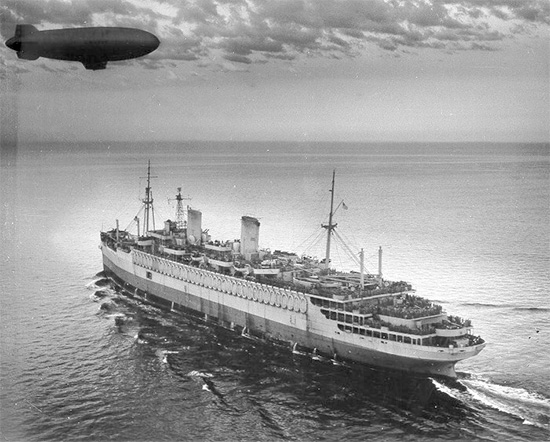
Vintage photo illustrating Troopship USS Wakefield, AP-21. This particular photo illustrates the ship which carried the personnel of the 37th Medical Hospital Ship Platoon from Southern France to Boston, Massachusetts, Zone of Interior, in May 1945.
21st General Hospital
29 December 1943 > 26 September 1944 – Naples-Caserta Medical Center, Italy
Following receipt of new orders, the organization left the hospital site by truck at 1315 hours and boarded the “Highland Chieftain” at 1450 hours for a return trip to North Africa. The unit sailed for Africa around 0715 in the morning of January 28, and debarked at Mers-El-Kébir, Algeria, at 1730 hours, January 31, from where they entrucked for the 180th Station Hospital for another assignment.
After only a short stay with the 180th Sta Hosp, the 37th boarded the USS “General Alexander E. Anderson”, AP-111 (launched May 2, 1943, she made 4 round-trip voyages out of Norfolk, Virginia to Casablanca, French Morocco between October 1943 and March 1944 –ed) February 1, and sailed for the United States at 1515 hours, February 2. The ship first made a stop-over in Casablanca, French Morocco, to pick up more troops and departed at 1700 hours, February 4, 1944.
Zone of Interior & Preparation for Overseas Movement:
The USS “General A. E. Anderson” docked at Hampton Roads Port of Embarkation, Virginia (US Army third largest TC Port of Embarkation in terms of passengers and second in terms of cargo during WWII –ed) at 1000 hours, February 13, 1944, with troops debarking the next day at 0500 in the morning. Upon debarkation, the Platoon was to proceed to Camp Patrick Henry, Oriana, Virginia (Staging Area for Hampton Roads Port of Embarkation; total acreage 1,649; troop capacity 1,621 Officers and 22,916 Enlisted Men –ed) and report for duty. All the men received a 10-day furlough + travel time to visit their family.
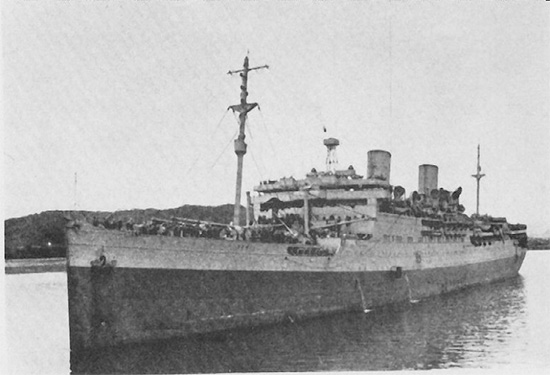
Vintage photo illustrating Troopship USS Hermitage, AP-54. This particular ship carried the staff and personnel of the 37th Medical Hospital Ship Platoon from Boston, Massachusetts to Le Havre and Cherbourg, France, end May early June 1945.
It was during the unit’s stay at Camp Patrick Henry, Virginia, that authorization to wear official EAME Campaign and Good Conduct ribbons was obtained, as per Authority Executive Order # 9265, Section 1, Bulletin No. 56, War Department 1942; and Authority Executive Order # 9323, Bulletin No. 6, War Department 1943. Subject authorization was issued by official Letter, Headquarters, 37th Medical Hospital Ship Platoon, Camp Patrick Henry, Virginia, dated March 17, 1944.
On February 23, the CO, Captain G. L. Walker, was taken sick to hospital. He was replaced by 1st Lieutenant James Mithoefer April 17, 1944, who was appointed acting Commanding Officer. Quite a few organizational changes were implemented such as, replacements came in, four EM were dropped from the rolls, including the CO, and all the Nurses were relieved from assignment as per orders. The new men were Staff Sergeant Louis Frazier and Private First Class Irving Rosenthal (five 5 EM were gone).
On April 15, the remaining organization left Camp Patrick Henry for Camp Shanks, Orangeburg, New York (Staging Area for New York Port of Embarkation; total acreage 2,009; troop capacity 2,545 Officers and 46,367 Enlisted Men –ed) where they arrived around 1415 hours, April 16, 1944. The new Commanding Officer, 1st Lieutenant J. Mithoefer, joined the Platoon at Camp Shanks and left together with the men April 21, entraining at 1700 hours for the pier where, following the required processing, they all boarded RMS “Mauretania” at 2030 hours, the same day.
United Kingdom:
RMS “Mauretania” sailed from New York harbor with a number of troops pertaining to Third United States Army, including the depleted 37th Medical Hospital Ship Platoon (Separate). She sailed alone and reached Liverpool, England, April 30, 1944. Following debarkation at 0600, May 1, 1944, the men entrained for the town of Llandudno, Wales, where they arrived at approximately 1130 hours.
Following an uneventful stay, the 37th returned to Liverpool May 27, where it was ordered to embark aboard USAT “Uruguay” (launched in 1927, operated as troopship by the War Shipping Administration between 1942 and 1946 –ed) at 1115 hours, for a return trip to the Zone of Interior. The ship sailed for home May 28, 1944 arriving in New York June 9. Following debarkation, the organization was once more transferred to Camp Shanks, Orangeburg, where it was to await further instructions.
Another re-organization followed during the month with transfer of 2 Enlisted Men out of the organization plus another man dropped, while Lieutenant James Mithoefer was replaced by 1st Lieutenant Levi E. Reynolds as acting Commander June 29, 1944.
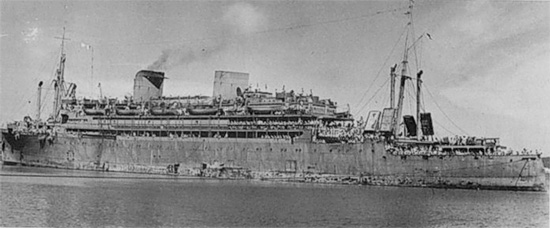
Vintage photo illustrating US Army Transport USAT Santa Rosa. This particular photo illustrates the ship which carried the staff and personnel of the 37th Medical Hospital Ship Platoon from Marseille, Southern France, to Hampton Roads Port of Embarkation, Zone of Interior, in July 1945.
The Platoon moved to Charleston, South Carolina where it arrived July 7. Another new replacement was received July 8.
After obtaining new orders, the small group embarked on USAHS “Algonquin” July 6, 1944 and sailed for Naples, Italy, where they arrived July 24. Instructions awaited the CO and following debarkation, the 37th moved to Bagnoli, Italy from where they were taken to the 118th Station Hospital for a temporary assignment.
118th Station Hospital
14 October 1943 > 20 May 1945 – Naples-Caserta Area, Italy
After a stay of approximately 2½ weeks, the Platoon boarded the USS “General Montgomery C. Meigs”, AP-116 (launched March 13, 1944 and commissioned June 3, 1944 –ed) with destination the ZI. Departure took place August 21 with arrival at HRPE (Hampton Roads Port of Embarkation –ed) September 1, 1944. From September 1 to September 8 the group was stationed at Camp Patrick Henry, Oriana, Virginia, until they were ordered to Charleston, South Carolina (which had become the main hub for Hospital Ships). Once there, all the men were awarded a 15-day furlough.
On October 3, 1944, the Platoon embarked aboard USAHS “Château Thierry”, another Hospital Ship, with destination the European Theater. Following arrival and debarkation at Bristol, England, the organization moved to the 98th General Hospital which it reached October 17.
The organization would eventually shuttle from one destination to another, often supplementing the current medical unit serving aboard the different Hospital Ships, as well as working on DS or special assignment to US Army Hospitals.
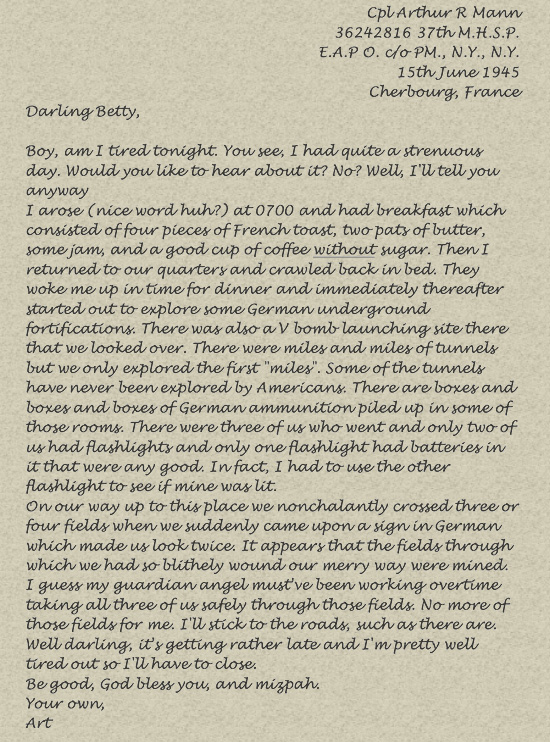
Copy of Letter written by Technician 5th Grade Arthur R. Mann to his dear wife Betty out of Cherbourg, Cotentin Peninsula, France, dated June 15, 1945.
Further Operations
October 19, 1944. The Platoon entrained for Plymouth, England, to embark on the USAT “Cristobal”.
November 1, 1944. The 37th arrived at New York harbor and moved to Camp Shanks.
November 6, 1944. The Platoon moved to Charleston, South Carolina, where it arrived the following day.
November 24, 1944. Private Woodrow Brewer was received, replacing Private Lewis B. Lee.
November 25, 1944. The 37th embarked on USAHS “Acadia”, with destination Italy.
December 9, 1944. The Platoon landed in Naples harbor and moved to join the 118th Station Hospital. Following receipt of new orders, the 37th was now attached to the 118th Station Hospital, located in the Naples-Caserta area. As from January 3, 1945, it was ordered to operate a dispensary in Bagnoli.
January 23, 1945. The Platoon boarded the “Ville d’Oran” (launched in 1936, ex-French armed merchant cruiser which operated in the Mediterranean and African region –ed), with destination Southern France.
January 24, 1945. The 37th debarked at Marseille harbor and was assigned to join the 638th Medical Clearing Company (Separate).
May 4, 1945. Technician 4th Grade Darrel B. Hammond and Technician 5th Grade Arthur R. Mann, 37th Medical Hospital Ship Platoon, were placed on TD (temporary duty) with the Provisional Hospital Train from Marseille to Nice, Southern France between May 4 and May 7, 1945.
May 11, 1945. The organization left aboard the USS “Wakefield”, AP-21 (launched December 6, 1930 and acquired by the US Navy June 14, 1941, commissioned June 15, 1941, between April 1944 and February 1946 transported 110,563 US troops to Europe and brought back 106,674 to the Zone of Interior, in many cases she operated as a “lone wolf”, without convoy protection, except for occasional air cover, nicknamed “The Boston & Liverpool Ferry” –ed) sailing for Boston, Massachusetts, Zone of Interior.
May 25, 1945. After landing at Boston harbor, the 37th moved to Camp Myles Standish, Boston, Massachusetts (Staging Area for Boston Port of Embarkation; total acreage 1,485; troop capacity 1,298 Officers and 23,100 Enlisted Men –ed). On May 28 Private Mark C. Grafton replaced Technician 5th Grade William Carroll, and Sergeant Harold W. Rossiter was transferred out (the USS “Wakefield” docked at Commonwealth Pier, Boston harbor, returning to the ZI carrying some 6,000 Vets of the Fifteenth Army Air Force, many of them wounded from the battles in Italy and the Mediterranean. Apart from the numerous Aviation, Bombardment, Depot, Engineer, Fighter, Ordnance, Quartermaster, Signal, and Supply units, the following Medical Hospital Ship Platoons were also on board: 34th – 37th – 481st – 485th – 487th – and 882d –ed).
May 30, 1945. The Platoon boarded USS “Hermitage”, AP-54 (launched in 1932, converted to troop transport and commissioned August 14, 1942 –ed) and sailed for France.
June 7, 1945. The organization arrived at Le Havre harbor, France.
June 8, 1945. The 37th sailed for Cherbourg aboard the USS “Hermitage”, where they arrived June 9. Following debarkation, the men were taken to the Dixmude Transient Camp, in the vicinity of Cherbourg, Cotentin Peninsula, France.
July 10, 1945. The Platoon embarked on USAT “Santa Rosa” (built in 1932, operated by the War Shipping Administration from 1941 to 1946, she made several round-trips to Le Havre and Cherbourg, France, with return to Hampton Roads Port of Embarkation, Virginia, in 1945, and moving to Marseille in September 1945 –ed) with destination the Zone of Interior.
July 19, 1945. The organization landed at Hampton Roads Port of Embarkation, Virginia and moved to Camp Patrick Henry, Oriana, where they were all given a 15-day delay enroute to their new assignment at Fort Hamilton, New York, starting July 20,
By Memorandum Letter issued by Headquarters, 37th Medical Hospital Ship Platoon, Embarkation Army Post Office, New York, dated May 23, 1945, and as per Authority War Department Circular No. 268, dated June 30, 1944, Authorization to wear Overseas Service Bars was extended to Technician 5th Grade Arthur R. Mann, and 14 fellow servicemen.
Technician 5th Grade Arthur R. Mann, MD, 36242816, was Honorably Discharged October 14, 1945 at Fort Sheridan Separation Center, Highwood, Illinois, after serving with the 9223d Technical Service Unit, Transportation Corps, Enlisted Transient Detachment # 3 (9223d TSU-TC EMB TRANS DET # 3). His personal ASR score was 74 points (September 2, 1945).
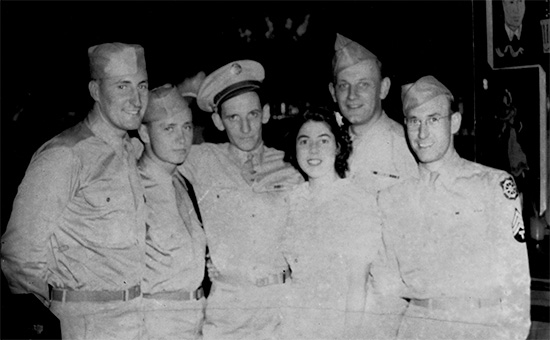
Photo illustrating Technician 5th Grade Arthur R. Mann, ASN 36242816 and fellow-members of the 37th Medical Hospital Ship Platoon (Separate) enjoying drinks at Jack Dempsey’s Broadway Bar & Cocktail Lounge (near Forty-Ninth Street, New York), August 29, 1945. At the time the unit was stationed at Fort Hamilton, New York, Zone of Interior.
Service & Awards Data – Tec 5 Arthur R. Mann
Induction/Entry May 29, 1942 – Fort Sheridan Military Post, Highwood, Illinois
Honorable Discharge October 14, 1945 – Fort Sheridan Military Post, Highwood, Illinois
Technician 5th Grade – MOS 409
Good Conduct Medal
Bronze Star Medal
European African Middle East Theater Ribbon with 3 miniature bronze battle stars:
Naples-Foggia Campaign Award (period September 9, 1943 > January 21, 1944)
Rome-Arno Campaign Award (period January 22, 1944 > September 9, 1944)
Rhineland Campaign Award (period September 15, 1944 > March 21, 1945)
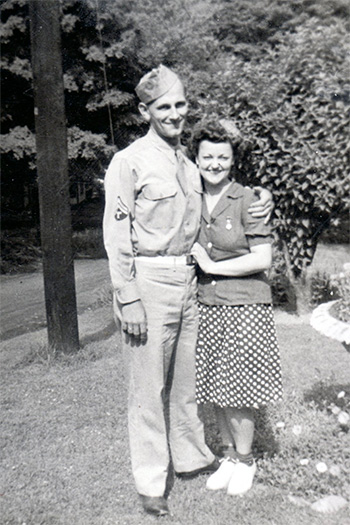
Photo illustrating Technician 5th Grade Arthur R. Mann and his wife Elizabeth C. Ochs. This photo was taken stateside some time in 1944, in between the organization’s many overseas movements.
List of used Abbreviations:
ANC > Army Nurse Corps – APO > Army Post Office – ASN > Army Serial Number – AWOL > Absent Without Leave
CO > Commanding Officer
DC > Dental Corps – DS > Detached Service
EAME > Europe-Africa-Middle East – EAPO > Embarkation Army Post Office – EM > Enlisted Man / Enlisted Men
MC > Medical Corps – MOS > Military Occupational Specialty – MRTC > Medical Replacement Training Center
NATOUSA > North African Theater of Operations, US Army – NCO > Noncommissioned Officer
PE / P/E / POE > Port of Embarkation – PW > Prisoner of War > PWE > Prisoner of War Enclosure
RMS > Royal Mail Ship (British)
SD > Special Duty – SP > Special Order
TC > Transportation Corps
USAHS > US Army Hospital Ship – USAT > US Army Transport – USS > United States Ship
VOCO > Vocal Orders Commanding Officer
ZI > Zone of Interior (Continental United States)
We are truly indebted to Russell A. Mann, son of Technician 5th Grade Arthur R. Mann (ASN:36242816), for allowing us to use his Father’s personal notes contained in a War Diary relating to the period during which he served with the 37th Medical Hospital Ship Platoon in the North African, Mediterranean and European Theaters. Without his precious help, editing this Testimony would not have been possible. We are still looking for more photographs illustrating personnel and locations of subject organization
